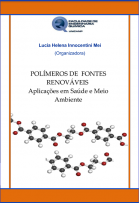Polímeros de fontes renováveis: aplicações em saúde e meio ambiente
Palabras clave:
Polímeros, Polímeros en medicina, Polímeros - Aspectos ambientalesSinopsis
O objetivo deste livro é levar ao público acadêmico e não acadêmico, o devido conhecimento sobre Biopolímeros e suas aplicações nas áreas da Saúde e Ambiental. Conceitos sobre polímeros biobased e biodegradáveis tem sido utilizados sem o conhecimento necessário para discernir sobre quando e porque utilizá-los. Na mesma linha, muito se fala em Biomassa mas pouco se divulga além das fronteiras acadêmicas, o potencial que ela oferece para se obter matérias-primas renováveis que serão utilizadas na produção de bens de commodities e de produtos de alta tecnologia para utilização nas áreas Médica, Farmacêutica, Biomédica, Odontológica, Biológicas, Engenharias (Materiais, Química, Alimentos, Ambiental, Civil, Agrícola, etc.).
Descargas
Citas
ABDEL-RAHMAN, M.A.; TASHIRO, Y. & SONOMOTO, K. “Recent advances in lactic acid production by microbial fermentation processes”. Biotechnology Advances, vol. 31, 2013, pp. 877-902.
AMASS, W.; AMASS, A. & TIGHE, B. “A review of biodegradable polymers: uses, current developments in the synthesis and characterization of biodegradable polyesters, blends of biodegradable polymers and recent advances in biodegradation studies”. Polymer International, vol. 47, 1998, pp. 89-144.
ARAYA-CLOUTIER, C.; ROJAS-GARBANZO, C. & VELAZQUES-CARILLO, C. “Effect of Initial Sugar Concentration on the Production of L(+) Lactic Acid by Simultaneous Enzymatic Hydrolysis and Fermentation of an Agro-Industrial Waste Product of Pineapple (Ananas comosus) Using Lactobacillus casei Subspecies rhamnosus”. Int. J. Biotechnol., vol. 506, 2012, pp. 91-100.
BABU, R.P.; O’CONNOR, K. & SEERAM, R. “Current progress on biobased polymers and their future trends”. Progr. Biomater., vol. 2, 2013, pp. 1-16.
BAYRAM, C. et al. “Preparation and characterization of triamcinolone acetonide-loaded poly(3-hydroxybutirate-co-3-hydroxyhexanoate) (PHBHx) microspheres”. J. Bioactive and Compatible Polymer, vol. 23, 2008, pp. 334-347.
BURGOS, N.; MARTINO, V.P. & JIMÉNEZ, A. “Characterization and ageing study of poly(lactic acid) films plasticized with oligomeric lactic acid”. Polym. Degrad. Stab., vol. 98, 2013, pp. 651-658.
CHEE, W.K. et al. “Impact toughness and ductility enhancement of biodegradable poly(lactic acid)/poly(-caprolactone) blends via addition of glycidyl methacrylate”. Adv. Mater. Sci. Eng., vol. 2013, 2013, 8 p.
CHEN, G.Q. & PATEL, M.K. “Plastics derived from biological sources: present and future: a technical and environmental review”. Chem. Rev., vol. 112, 2012, pp. 2082-2099.
CHEN, G.Q. & QIONG, W. “The application of polyhydroxyalkanoates as tissue engineering materials”. Biomaterials, vol. 26, 2005, pp. 6565-6578.
CHEN, Q.Z. et al. “Biomaterials in cardiac tissue engineering: ten years of research survey”. Materials Sci. Eng.: Reports, vol. 59, 2008, pp. 1-37.
CHIENG, B.W. et al. “Poly(lactic acid)/poly(ethylene glycol) polymer nanocomposites: effects of graphene nanoplatelets”. Polymers (Basel), vol. 6, 2013, pp. 93-104.
CLARINVAL, A.M. & HALLEUX, J. “Classification of biodegradable polymers. Part 1”. In: SMITH, R., Ed. Biodegradable polymers for industrial applications, 1. Ed., Boca Raton, CRC Press, Florida, USA, 2005, p. 552.
DE ROO, G. Et al. “Production of chiral R-3-hydroxyalkanoic acids and R-3-hydroxyalkanoic acid methylesters via hydrolytic degradation of polyhydroxyalkanoate synthesized by pseudomonas”. Biotechnol. Bioeng., vol. 77, 2002, pp. 717-722.
DOI, Y. Microbial Polyesters, VCH Publishers, New York, USA, 1990, 156 pp.
FEI, T. Et al. “Effective Recovery of Poly-β-Hydroxybutyrate (PHB) Biopolymer from Cupriavidus necator Using a Novel and Environmentally Friendly Solvent System”. Biotechnology Progress, vol. 32, 2016, pp. 678-685.
FREIER, T. Et al. “In vitro and in vivo degradation studies for development of a biodegradable patch based on poly(3-hydroxybutyrate)”. Biomaterials, vol. 23, 2002, pp. 2649-2657.
JACQUEL, N. et al. “Synthesis and properties of poly(butylene succinate): efficiency of different transesterification catalysts”. J. Polym. Sci. Part A : Polym. Chem., vol. 49, 2011, pp. 5301-5312.
JAMSHIDIAN, M. et al. “Poly-lactic acid: production, applications, nanocomposites, and release studies”. Comprehensive Rev. Food Sci. Food Safety, vol. 9, 2010, pp. 552-571.
JIANG, G. et al. “Carbon sources for polyhydroxyalkanoates and an integrated biorefinery”. Int. J. Mol. Sci., vol. 17, 2016, p. 1157.
KATHIRASER, Y. et al. “Chemical Characterization of 34etero-chain length polyhydroxyalkanoates (PHAs) recovered by enzymatic treatment and ultrafiltration”. J. Chem. Tech. Biotech., vol. 82, 2007, pp. 847-855.
KUNZE, C.; EDGAR, B.H. & ANDROSCH, R. “In vitro and in vivo studies on blends of isotactic and atactic poly(3-hydroxybutyrate) for development of a dura substitute material”. Biomaterials, vol. 27, 2006, pp. 192-201.
LACKNER, M. “Bioplastics”. Kirk-Othmer Encyclopedia of Chemical Technology, 2015, pp. 1-41.
LANGER, R. & TIRRELL, D.A. “Designing materials for biology and medicine”. Nature,vol. 428(6982), 2004, pp. 487-492.
LEBARBÉ, T. et al. “Fatty acid-based thermoplastic poly(ester-amide) as toughening and crystallization improver of poly(L-lactide)”. Eur. Polym. J., vol. 65, 2015, pp. 276-285.
LIU, L. et al. “Biodegradability of PBS composite reinforced with jute”. Polym. Degrad. Stab., vol. 94, 2009b, pp. 90-94.
LIU, L. Et al. “Mechanical properties of poly(butylene succinate) (PBS) biocomposites reinforced with surface modified jute fibre”. Composites Part A: Appl. Sci. Manufacturing, vol. 40, 2009a, p. 669-674.
LIU, M.; ZHANG, Y. & ZHOU, C. “Nanocomposites of halloysite and polylactide”. Appl. Clay Sci., vol. 75-76, 2013, pp. 52-59.
LJUNGBERG, N. & WESSLÉN, B. “Tributyl citrate oligomers as plasticizers for poly (lactic acid): 38eteroa-mechanical film properties and aging”. Polymer (Guildf), vol. 44, 2003, pp. 7679-7688.
MARTIN, O. & AVÉROUS, L. “Poly(lactic acid): plasticization and properties of biodegradable multiphase systems”. Polymer (Guildf), vol. 42, 2001, pp. 6209-6219.
MARTINEZ, F.A.C. et al. “Lactic acid properties, applications and production: A review”. Trends Food Sci. Technol., vol. 30, 2013, pp. 70-83.
McCHALICHER, C.W. & SRIENC, F. “Investigating the structure-property relationship of bacterial PHA block copolymers”. J. Biotechnology, vol. 132, 2007, pp. 296-302.
MOCHIZUKI, M. Properties and Application of Aliphatic Polyester Products. Biopolymer, Part 4, Polyesters. New York, Wiley & Sons, River Street, Hoboken, 2005.
MOHANTY, A.K.; MISRA, M. & HINRICHSEN, G. “Biofibres, biodegradable polymers and biocomposites: An overview”. Macromol. Mater. Eng., vol. 276-277, 2000, pp. 1-24.
MOHAPATRA, A.K.; MOHANTY, S. & NAYAK, S.K. “Effect of PEG on PLA/PEG blend and its nanocomposites: a study of 38eteroa-mechanical and morphological characterization”. Polym. Compos., vol. 35, 2014, pp. 283-293.
PANESAR, P.S. et al. “Production of L(+) Lactic Acid using Lactobacillus casei from Whey”. Brazilian Archives of Biology and Technology, vol. 53, 2010, pp. 219-226.
PEREGO, G. & CELLA, G.D. “Mechanical properties”. In: AURAS R.; LIM L.T.; SELKE, S.E.M. & TSUJI, H., Eds. Poly(Lactic Acid): Synthesis, Structures, Properties, Processing and Applications, Wiley, New Jersey, USA, 2010, pp. 141-154.
PHILIP, S.; KESHAVARZ, T. & ROY, I. “Polyhydroxyalkanoates: biodegradable polymers with a range of applications”. J. Chemical Tech. Biotech., vol. 82, 2007, pp. 233-247.
PUCHALSKI, M. et al. “Molecular and Supramolecular Changes in Polybutylene Succinate (PBS) and Polybutylene Succinate Adipate (PBSA) Copolymer during Degradation in Various Environmental Conditions”. Polymers, vol. 10, 2018, pp. 1-12.
REIS, K.C. et al. “Characterization of polyhydroxybuty-hydroxyvalerate (PHB-HV) maize starch blend films”. J. Food Eng., vol. 89, 2008, pp. 361-369.
RUTH, K. et al. “Efficient production of I-3-hydroxycarboxylic acids by biotechnological conversion of polyhydroxyalkanoates and their purification. Biomacromolecules, vol. 8, 2007, pp. 279-286.
SAVENKOVA, L. et al. “Mechanical properties and biodegradation characteristics of PHB-based films”. Process Biochem., vol. 35, 2000, pp. 537-579.
SODIAN, R. et al. “Early in vivo experience with tissue engineered trileaflet heart valves”. Circulation, vol. 102, 2000, pp. 22-29.
SRITHEP, Y.; NEALEY, P. & TURNG, L.-S. “Effects of annealing time and temperature on the crystallinity and heat resistance behavior of injection-molded poly(lactic acid)”. Polym. Eng. Sci., vol. 53, 2013, pp. 580-588.
STEINBUCHEL, A. & VALENTIN, H.E. “Diversity of bacterial polyhydroxyalkanoic acids”. FEMS Microbiol. Lett. Vol. 128, 1995, pp. 219-228.
SUBRAMANIAN, M.R.; TALLURI, S. & CHRISTOPHER, L.P. “Production of lactic acid using a new homofermentative Enterococcus faecalis isolate”. Microb. Technol., vol. 8, 2015, pp. 221-229.
TASKILA, S. & OJAMO, H. “The Current Status and Future Expectations in Industrial Production of Lactic Acid by Lactic Acid Bacteria”. In: KONGO, M., Ed. Lactic Acid Bacteria – R and D – for Food, health and Livestock Purposes. Oulu, Finland, InTech, 2013, pp. 615-632.
TODO, M. & TAKAYAMA, T. “Fracture Mechanisms of Biodegradable PLA and PLA/PCL Blends”. In: PIGNATELLO, R., Ed. Biomaterials – Physics and Chemistry, InTech, 2011, pp. 375-394.
TURESIN, F.; GURSEL, I. & HASIRCI, V. “Biodegradable polyhydroxyalkanoate implants for osteomyelitis therapy: in vitro antibiotic release”. J. Biomater. Sci. Polym., vol. 12, 2001, pp. 195-207.
VALAPPIL, S.P. et al. “Biomedical applications of polydroxyalkanoates, an overview of animal testing and in vivo responses”. Expert Rev. Med. Devices, vol. 3, 2006, pp. 853-868.
VINK, E.T.H. et al. “The eco-profiles for current and near-future NatureWorks polylactide (PLA) production”. Industrial Biotechnology, vol. 3, 2007, pp. 58-81.
VOLOVA, T. et al. “Results of biomedical investigations of PHB and PHB/PHV fibers”. Biochem. Eng. J., vol. 16, 2003, pp. 125-133.
VROMAN, I. & TIGHZERT, L. “Biodegradable Polymers”. Materials, vol. 2, 2009, pp. 307-344.
WALLE, G.A.M. et al. “Properties, modifications and applications of biopolyesters”. Adv. Biochem. Eng. Biotechnol., vol. 71, 2001, pp. 264-291.
WANG, J.; ZHAI, W. & ZHENG, W.-G. “Poly(ethylene glycol) grafted starch introducing a novel interphase in poly(lactic acid)/poly(ethylene glycol)/starch ternary composites”. J. Polym. Environ., vol. 20, 2012, pp. 528-539.
WANG, R. et al. “Morphology, mechanical properties, and durability of poly(lactic acid) plasticized with di(isononyl) cyclohexane-1,2-dicarboxylate. Polym. Eng. Sci., vol. 49, 2009, pp. 2414-2420.
WANG, Z. et al. “Novel transdermal drug delivery system with polyhydroxyalkanoate and starburst polyamidoamine dendrimer”. J. Biosci. Bioeng., vol. 95, 2003, pp. 541-543.
WILLIAMS, S.F. et al. “PHA applications: addressing the price performance Issue: I. Tissue engineering”. Int. J. Biol. Macromolecules, vol. 25, 1999, pp. 111-121.
YANG, Y. et al. “Study on chitosan and PHBHHx used as nerve regeneration conduit material”. J. Biomedical Eng., vol. 19, 2002, pp. 25-29.
YING, T.H. et al. “Scaffolds from electrospun polyhydroxyalkanoate copolymers: fabrication, characterization, bio absorption and tissue response”. Biomaterials, vol. 29, 2008, pp. 1307-1317.
ZHAO, K. et al. “Production of D-(-)-3-hydroxyalkanoic acid by recombinant Escherichia coli”. FEMS Microbiol. Lett., vol. 218, 2003, pp. 59-64.

Descargas
Publicado
Categorías
Licencia

Esta obra está bajo una licencia internacional Creative Commons Atribución-NoComercial-CompartirIgual 4.0.





